This Secret Corner of California Is a Paradise for Lovers of Great Food and Top-Notch Wines
Jody Rosen meets the free spirits giving shape to this flourishing wine region with a soon-to-be-legendary culinary scene, California’s Mendocino County
/https://tf-cmsv2-smithsonianmag-media.s3.amazonaws.com/filer/3f/42/3f422644-6cea-4e61-aca4-3764895dd17e/anderson-valley-vineyard-mendocino0618.jpg)
Seemingly everyone you meet in Anderson Valley can tell you a migration story that has the flavor of myth — a tale that casts their arrival in this shockingly picturesque corner of California’s Mendocino County as the climax of a great quest, or the punch line of a cosmic joke, or both. One of the best yarns, surely, is Bruce Anderson’s. In 1971, Anderson, an avowed “big hippie,” rolled out of San Francisco in a Volkswagen bus, heading, like many pilgrims of the period, back to the land. For years, Anderson had lived in the thick of San Francisco’s counterculture. He had played a leading role in anti–Vietnam War protests. But as the 60s turned into the 70s, the city’s bohemian enclaves were gripped by malaise, Flower Power dreams withering amid rising violence and a plague of hard drugs. So Anderson hit the road with his wife, his young son, his brother, and a handful of friends, heading up the coast in a caravan, seeking spiritual rejuvenation in a landscape of stretching redwoods and soaring oceanside cliffs. And they had another plan in mind: to raise a dozen troubled Bay Area foster children in the countryside, far from the deprivations and vices of city life.
Anderson and company hadn’t decided exactly where they were headed, but the decision was soon made for them. About 125 miles northwest of San Francisco, Anderson pulled into a service station in a tiny town whose name, Boonville, made no secret of the fact that it was, well, the boondocks. “We barely knew where we were,” Anderson recalled. “We just happened to run into a guy who told us there was a ranch for lease south of town.”
They drove to the ranch and stayed. The basics of rural homesteading proved a mystery. (“Gravity-flow water systems, septic tanks — all that was completely new,” Anderson said.) As for the foster kids, that plan didn’t work out too well: “We had the delusional idea that juvenile delinquents would be less delinquent under the redwoods than they were under streetlights. They turned out to be twice as delinquent.”
But nearly a half-century later, Bruce Anderson has become so synonymous with Anderson Valley that he’s often mistakenly assumed to be its namesake. Today he lives with his wife in the center of Boonville. He works steps away, in a 40-foot trailer that serves as the headquarters of the Anderson Valley Advertiser, the weekly newspaper that he has owned, edited, and largely written for 34 years. At 78, Anderson looks and sounds the part of an éminence grise, with an ample white beard and a commanding basso profundo. He is a fount of local lore. Ask for a history lesson and he will tell you about successive generations of economic refugees, fortune seekers, and utopian questers who made their way to the valley: the European pioneers who pushed into Pomo Indian country in the mid 19th century; the Arkies and Okies who arrived after World War II, finding work in the then-booming timber industry; the members of his own hippie tribe, who came in the 70s, buying up cheap logged-over land where they raised kids and communed with nature.
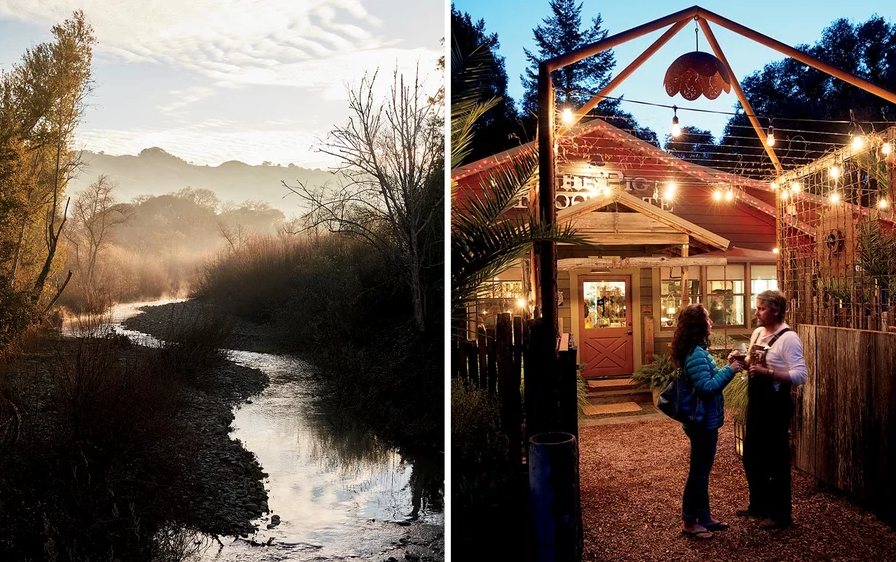
A fourth wave of Anderson Valley migration is under way. The climate and topography that for decades nurtured the valley’s agricultural staples — first apples and pears, then cannabis—has proven ideal for growing grapes, especially Pinot Noir. Today, Anderson Valley is California’s most exciting emerging wine region, a magnet for the 21st century’s new class of NoCal back-to-the landers: oenophiles, foodies, and others who want to live simply but sumptuously. Travelers who once bypassed the valley, following the siren call of Mendocino’s famous coastline, are increasingly journeying inland. What they find there is bounteous farmland and deep forests, a food-and-wine scene slowly but steadily coming into its own, a place that has maintained the funkiness that was long ago gentrified out of the county’s more well-trafficked communities. For locals, the transformation of Anderson Valley is nothing short of surreal. “It’s like something out of science fiction,” marveled Anderson. “Everywhere you look, you see vineyards coming over the ridge.”
My first glimpse of Anderson Valley came on a vibrant morning, when the sun streamed through cracks in a ceiling of magnificent gray-white clouds. The night before, I’d completed my own trek to the valley from San Francisco. The last leg of the journey was hair-raising: a 30-mile-long drive along fearsomely twisty Route 128, which slaloms north and west across a forested mountain pass before dropping into the valley at Boonville. (Locals credit the challenging drive with keeping the area’s population down.) I quickly got my reward in the form of an early lunch at Boonville’s Pennyroyal Farm, which for the last decade has been producing excellent wines and the valley’s most famous small-batch cheeses.
In the tasting room, locals and visitors crowded around the bar, sampling whites and rosés. I made my way outside, taking a table on a canopied patio that offered views of the vineyard. Twenty-three acres of Sauvignon Blanc and Pinot Noir grapevines lace a landscape roamed by sheep that do double duty as cheese suppliers and weeders of the vineyard floor. The food arrived on heaping platters: charcuterie; pickled vegetables; a big dollop of Laychee, Pennyroyal’s signature goat cheese; a slab of Boont Corners Vintage Tomme, a tangy, salty goat-and-sheep-milk cheese. I washed it down with a bracing Blanc. A couple seated at the next table, Pennyroyal regulars, told me, “You can’t leave without trying the Pinot.” The advice was less a suggestion than a command; it seemed foolish to ignore it. The pour of the day was Pennyroyal’s 2015 Jeansheep Vineyard Pinot, dark and spicy with notes of morello cherry. I ordered a glass, drank it, and ordered a second.
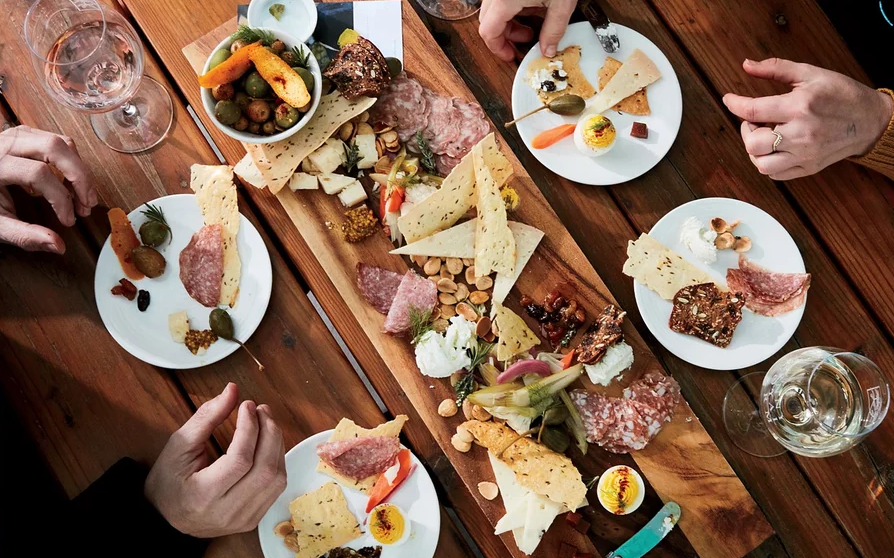
The first Anderson Valley vineyards appeared in the 1970s, but it was the arrival of legendary French champagne maker Louis Roederer in the early 80s that established the region’s bona fides. Since then, dozens of vintners have set up shop, specializing in wines that thrive in the region’s distinctive terroir. Anderson Valley is a narrow strip, just 25 miles long, tucked between coastal redwoods and inland oaks. It’s threaded by the Navarro River, which passes through Boonville and two smaller hamlets, Philo and Navarro, on its way to the Pacific. In summer, fog drapes the valley in the morning. Afternoon temperatures can reach 100 degrees; in the evening, the thermometer may plummet 40 or 50 degrees. “When it comes to grapes, the temperate climate here makes all the difference,” said Matt Parish, a winemaker from New Zealand who in 2017 took the helm at Philo’s Lula Cellars. “You get that nice, even ripeness without blowing out the fruit flavors in too-hot weather.”
Lula Cellars is a favorite of valley cognoscenti. The wine is superb: meaty Pinots, holding lingering notes of dark fruit, with tannins that tickle the palate. The vibe at the vineyard is High Quirky. The tasting room manager, Dan Reed, is a burly man with a courtly manner and a wit as dry as the Pinots he pours. His business card reads pushy salesman, but his technique leans more toward gentle persuasion. “I think you’ll like this,” he told me, offering a glass of 2014 Costa Pinot Noir. (I liked it.) Reed lives on the property, in a house that he shares with Honey, a yellow Labrador mix, who has her own Lula business card (head of barketing). When visitors bring their dogs—a practice Lula encourages—Honey leads them on bombing runs into the vineyard’s pond to chase frogs. Honey often rides shotgun in Lula’s house car, a vintage Morris Minor, when Reed does errands in Philo and Boonville. “Me and Honey, we’re a little bit famous around here,” Reed said.
In years past, visitors who sought upscale lodging were forced to leave Anderson Valley and spend their nights on the coast, where options are plentiful. But today the valley has its own high-end Shangri-La, which sacrifices nothing in the way of amenities while offering the kind of oddity that can’t be faked.
The Madrones stands behind a grand gateway entrance in Philo, just across the Boonville line. The property includes a rose garden and a working farm. There are tasting rooms for three local wineries and an excellent little restaurant, Stone & Embers, that serves exquisite wood-fired pizzas and small plates.
There are four guest rooms in the compound’s main building, and five more in guest houses situated on the raffishly landscaped grounds. The rooms are appointed with a variety of antiques, nearly all from the collection of Jim Roberts, the owner. Weirder items from his stash—19th-century German anatomy posters, Victorian embalming machines—are on sale in the hotel’s curiosity shop, the Sun & Cricket. The main building has the look of a Mediterranean villa, with a shady courtyard and tiled roof. But there’s also a scattering of Asian statuary, a huge bronze dragon that presides over the hotel’s circular drive, and two fierce Chinese lions painted a lurid shade of pink. The first time I met Roberts, I confessed that I found the architectural hodgepodge delightful but disorienting. “Is this Tuscany? Spain? China? I’m not sure where I am,” I told him. “Good,” he said.
Roberts grew up in Orange County, California. “I always wanted to live in Mendocino,” he said. “I read about it. I dreamed about it. So I packed up my car and went.” For years the property was his home and the office for his now-shuttered interior design firm. In 2011, Roberts decided to try his hand at hospitality and, in the succeeding years, has gradually expanded the Madrones. Now, Roberts and his partner in business and life, Brian Adkinson, have added an adjacent property to the compound. One afternoon they took me to the Brambles, which occupies sprawling acreage in a grove of old-growth redwoods a short distance from the Madrones. The Brambles’ guesthouse, holding three spacious suites, is a Victorian stick-and-shingle structure. It looked like something out of a Grimms’ fairy tale.
Roberts and Adkinson epitomize the new breed of Anderson Valley refugees: creative, unconventional, entrepreneurial. On Boonville’s main drag, you can shop at Farmhouse Mercantile, a housewares emporium as tastefully rustic-chic as any in San Francisco’s hipster redoubts. Even the old Boonville Hotel—which dates back to the town’s rugged mid-19th-century frontier era—bills itself as a “modern roadhouse” where the restaurant serves food “inspired by whim and season.” It’s a big change for a place that has always been hardscrabble. A century ago, Boonvillians developed a language impenetrable to outsiders, Boontling. (A few old-timers still speak the argot, which is heavy on sexual and scatological terms: “moldunes” are large breasts; to “burlap” is to have intercourse.) On weekends, the streets ran with blood from bare-knuckle bar fights, and the brothels heaved. “This was wild country,” Bruce Anderson told me. “Lots of little mill shacks and people who worked hard, played hard.”
The valley grew more sedate when the timber mills began to shutter in the late 50s and 60s. But the outlaw spirit endured in the formerly illicit trade that has formed the backbone of Mendocino’s economy since the 70s: growing and selling marijuana. On New Year’s Day 2018, California’s first retail weed shops opened their doors, and the question hovering over the region today is how life will transform in the era of legalization. Everywhere you go in Anderson Valley, you hear grumblings that the pot business is facing a corporate takeover and that mom-and-pop growers will be left in the cold. Some imagine a time when marijuana farms and tasting rooms will line Route 128 alongside the vineyards, with “ganja sommeliers” proffering varietals to “weed tourists.” But if that day comes, who will reap the profits?
For now, the answers—like the pungent scent of Mendocino cannabis that locals proudly pronounce the world’s best—are blowing in the wind. In the meantime, curious new forms of life are taking root in the valley’s loamy soil. Oddly enough, the place that may best embody Anderson Valley’s iconoclastic spirit is its fanciest restaurant.
The Bewildered Pig sits on an otherwise sparsely developed stretch of 128 in Philo, about two miles south of the Navarro line. Janelle Weaver, the Bewildered Pig’s chef, and her partner, Daniel Townsend, fit the archetypal profile of Mendocino pilgrims. For seven years, they rolled up and down the coast in their 1978 Volkswagen Westphalia camper, seeking the ideal spot for the restaurant they envisioned. Weaver grew up in Michigan and Alaska, where she hunted and fished with her family; her first professional cooking job was at a breakfast counter, at age 12. Townsend spent much of his childhood on the White Mountain Apache reservation in Arizona. (His father was a missionary.) The couple met in 2004, in Napa Valley, where both had worked for years as chefs. Townsend is also a landscape designer and tinkerer whose touch is all over the Pig: a “cactus wall” that shields outdoor diners from traffic; gurgling fountains ingeniously crafted from repurposed industrial scraps; a gorgeous adjacent patio, where they plan to host DJ nights and other events. The dining room is an enchanted space. Weaver and Townsend like to throw around the term “refined rustic,” an apt description of both their design aesthetic and Weaver’s astonishing cooking.
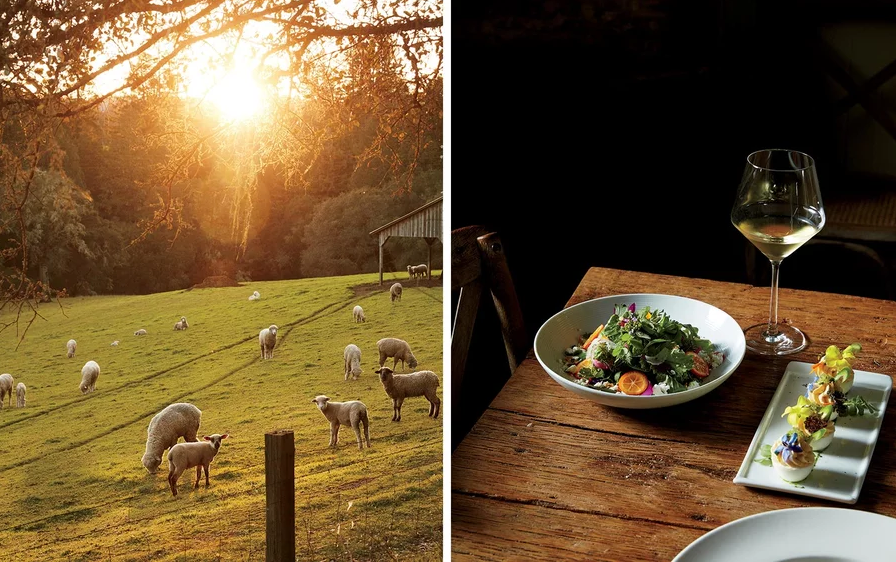
I had one of the great meals of my life at the Pig. It was a lavish six-course tasting menu with wine pairings, highlighted by dishes like the explosively flavorful spruce-tip custard garnished with maitake mushrooms and locally foraged herbs, and an obscenely delicious sunchoke bisque with house-smoked black cod and smoked trout roe. There are notes of Eastern European cooking in Weaver’s plates. (Her Polish grandmother was an early influence.) There is a classical French sense of balance, too, and the requisite Alice Watersian emphasis on garden-fresh ingredients and regional sources.
But Weaver’s style is bold and unusual; an inventory of influences doesn’t tell the tale. Maybe, eventually, Weaver’s innovative food will simply be called Anderson Valley Cuisine. To say that the Bewildered Pig is the valley’s best restaurant is not to insult the area competition: soon enough, it may be the best restaurant in California. With its mix of revelatory food, conviviality, and ambition without pretension, it feels like a dream of what a restaurant should be.
Tourism isn’t rocket science. But Anderson Valley is the kind of place where you can get sightseeing advice from a rocket scientist. While sipping Pinot at the Lula Cellars tasting room one afternoon, I met a Lula regular, Todd Lukes, a southern California expat who moved to Mendocino five years ago. Lukes has the languid, sun-fried look of an aging surfer, but he works in the aeronautics industry. After quizzing me about my visit to the valley, he concluded that I’d spent too little time experiencing its natural wonders. He asked if I’d explored Hendy Woods State Park in Philo. Yes, I’d done that: I’d been struck dumb by the cathedral-like groves of ancient redwoods. “Then you have to head to the beach,” Lukes said. “You can’t leave Mendo without hitting the coast.” Where exactly should I go? “Blues Beach, just outside the town of Westport. There’s no sign. But you’ll know it when you see it.”
Lukes was right. On a shimmering morning I guided my rental car down the steep curves of Route 1 until I spotted a little jog off the big road. I practically drove right onto the beachfront, an unspoiled, unpeopled coastline that seemed to stretch to infinity. I scrambled down to the sand and marched north, stepping over chunks of seaweed the size of large squid, with the wind and surf roaring. It was a scene of almost unseemly beauty. The sky was a deep, dusty blue, roiled by swiftly moving clouds. About 500 yards from the beach, two giant outcroppings rose from the deep—rocks that animist ancients might have worshipped as gods. This was Mendocino utopia: a place on the edge of the continent, where nature at its most untrammeled is on display, and freedom seems absolute.
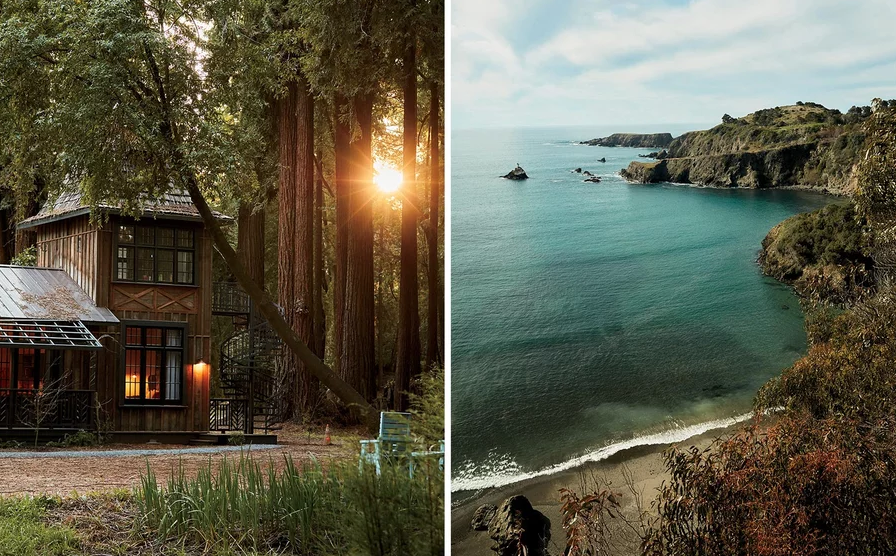
An hour passed, maybe two. It was time I moved along. The next day I would have to follow Route 128’s zigzags out of the valley, to Route 101 South and on to San Francisco to catch a flight back to the East Coast. In the meantime, I longed to get back to the valley, which offers its own mellow version of splendid isolation: a glass of something strong and red, a vineyard vista, a landscape gradually turning deep blue as the sun drops into the sea on the far side of the pine-lined ridges. I remembered a comment Jim Roberts made about Anderson Valley’s slowly-but-steadily rising profile. “The secret is out,” Roberts said. “But, you know, it’s not tooout.”
Exploring Mendocino County
Three days in Anderson Valley allows time to sample local wines, experience gastronomic nirvana, and immerse yourself in natural beauty. Add two or three days to your itinerary to visit the county’s famously dramatic coastline.
Getting There
The scenic way to reach Mendocino County from San Francisco is Route 1, which winds along the coastline. The drive takes roughly four hours; stop at Point Reyes National Seashore if time allows. If you’re in a hurry, take inland Route 101 to Route 128, which reaches Anderson Valley in three hours.
Anderson Valley
Lodging
Boonville Hotel In the 19th century, this place was a raucous roadhouse. Today, it has 15 comfortable rooms, including a private creekside bungalow with a screened-in porch. Boonville; boonvillehotel.com; doubles from $155.
The Brambles From the owners of the nearby Madrones hotel, this renovated homestead in a secluded redwood grove has three suites and two adjacent cabins. Philo; themadrones.com/the-brambles; doubles from $250.
The Madrones Nine accommodations in a gorgeous setting that is part Tuscany, part Alice’s Wonderland. Philo; themadrones.com; doubles from $252.
Philo Apple Farm Hidden in one of the valley’s last fruit orchards is this exclusive hotel with four chic guest cottages. Visitors can choose to “just stay” or to “stay and cook,” joining staff in hands-on farm-to-table meal preparation. Philo; philoapplefarm.com; doubles from $300.
Food & Drink
Anderson Valley Brewing Co. This 30-year-old valley institution is one of the country’s pioneering craft-beer makers. Try Frisbee golf on an 18-hole course that wends through oak groves and pasture. Boonville; avbc.com.
Bewildered Pig The Anderson Valley culinary revolution starts here. Janelle Weaver’s “refined rustic” food will bowl you over; the dining room feels like your long-lost home. Book in advance. Philo; bewilderedpig.com; entrées $26–$32.
Goldeneye Winery “The Pearly Gates of Pinot Noir” is this vineyard’s none-too-humble tagline, but the wine merits the boast. Experience an Essentials Tasting for $15, or book the Elevated Tasting, a deep dive into the winery’s portfolio. Philo; goldeneyewinery.com.
Lula Cellars The wines are delicious and surprisingly complex; the vineyard views, gorgeous. Philo; lulacellars.com.
Navarro Vineyards One of the valley’s oldest vintners, with a charming, barnlike tasting room. The Pinots are big and flavorful, but don’t miss the Gewürztraminer. Philo; navarrowine.com.
Pennyroyal Farm Come for the farmstead cheeses, stay for the wine. Anderson Valley’s most hopping lunch scene. Boonville; pennyroyalfarm.com.
Stone & Embers This delightful restaurant on the Madrones property makes the most of its tiny space. The inventive wood-fired pizzas have toppings like “turducken sausages.” Philo; stoneandembers.com; entrées $15–$19.
Table 128 The Boonville Hotel’s restaurant serves family-style dinners. Reservations are a must. Boonville; boonvillehotel.com/eat; prix fixe from $38.
Activites
Hendy Woods State Park To step into the redwood groves is to enter a sublime space—nature’s own Chartres Cathedral. The trees are towering (some stretch to 300 feet) and ancient (some are more than 1,000 years old). Philo; parks.ca.gov.
Shopping
Farmhouse Mercantile This lovely Boonville shop sells housewares, clothing,
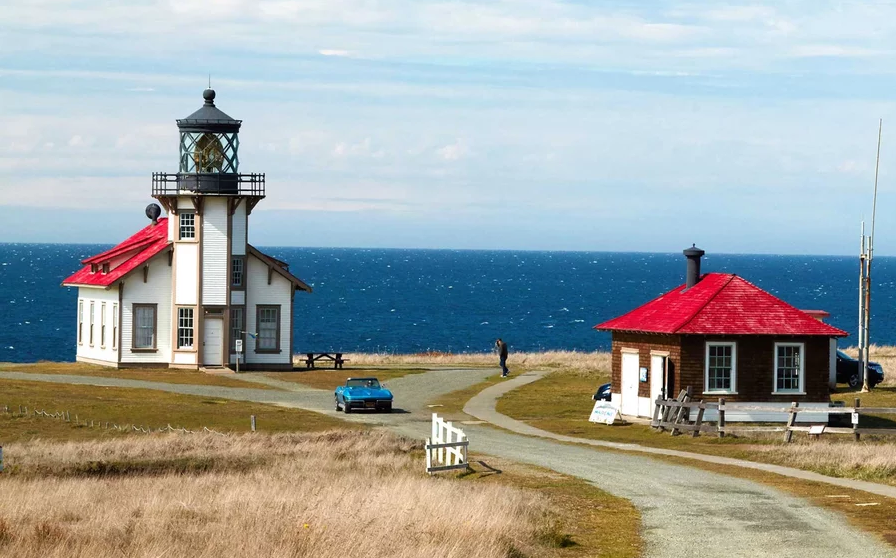
The Coast
Lodging
Brewery Gulch Inn A perennial on T+L’s World’s Best list, Brewery Gulch Inn overlooks a spectacular swathe of coastline. The inn combines the best elements of luxe resort, bed-and-breakfast, and rec room; in the high-beamed dining-room-cum-lounge there are plush couches, board games, and picture windows that frame eye-popping views. Mendocino; brewerygulchinn.com; doubles from $385.
Inn at Newport Ranch This brand-new hotel is situated on a 2,000-acre working ranch with more than a mile of private coastline. Take advantage of the hiking, biking, and horseback-riding trails that run through the property. Fort Bragg; theinnatnewportranch.com; doubles from $375.
JD House This just-renovated bed-and-breakfast is named for John Dougherty, its original resident. The rooms are a modern take on a sea captain’s quarters, with fireplaces and Persian rugs. Mendocino; bluedoorgroup.com; doubles
from $159.
Food & Drink
Circa ’62 at the Inn at Schoolhouse Creek A quaint inn uphill from Route 1 serves a decadent brunch. Menu highlights include kimchi pancakes and bacon-and-sweet-corn hash. Little River; schoolhousecreek.com; entrées $7–$17.
Trillium Café Housed in a whitewashed clapboard house, this restaurant is beloved for its quintessential California cuisine with an emphasis on fresh seafood. Mendocino; trilliummendocino.com; entrées $24–$37.
Wild Fish At this Pacific Coast Highway restaurant on the cliffs above Little River Cove, all ingredients come from local purveyors or are grown on the property. Little River; wild-fish.com; entrées $22–$39.
Activites
Blues Beach Located just south of the town of Westport off Route 1, this pristine stretch of shore is officially known as Chadbourne Gulch Beach. You can drive your car right onto the sand.
Mendocino Headlands State Park The town of Mendocino is surrounded by 347 acres of protected green space. Visit for the pleasant nature trails and the park’s two beaches, which draw fishers, sailors, and scuba divers. Mendocino; parks.ca.gov.
Skunk Train This 133-year-old train line, nicknamed for its diesel fumes, winds through the forest for more than 40 miles. Fort Bragg; skunktrain.com; adult fares from $25. — Jody Rosen and Hannah Walhout
This content was produced with the assistance from Brewery Gulch Inn and the Madrones.
Other articles from Travel + Leisure:
- Your Next Favorite European Wine Region Isn’t in France, Italy, or Spain
- How to Have a European Wine Bar Experience Without Leaving the U.S.
- Jim Beam Will Fly You and Your Dad to Kentucky to Bond Over Bourbon for $25
Planning Your Next Trip?
Explore great travel deals
Smithsonian magazine participates in affiliate link advertising programs. If you purchase an item through these links, we receive a commission.